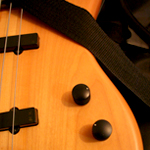 For the more advanced player, fretless bass guitars are a good way to hone your skills and get more sound from your instrument. Unlike their fretted cousins, fretless bass guitars lack the textured board. As a player, this means your have to have an excellent ear and a good knowledge of the bass guitar to play. Without the frets, you have to know what sounds each chord makes, as well as have excellent finger memory. Fretless bass guitars are not for beginners.
For the more advanced player, fretless bass guitars are a good way to hone your skills and get more sound from your instrument. Unlike their fretted cousins, fretless bass guitars lack the textured board. As a player, this means your have to have an excellent ear and a good knowledge of the bass guitar to play. Without the frets, you have to know what sounds each chord makes, as well as have excellent finger memory. Fretless bass guitars are not for beginners.
There are two types of fretless bass guitars available. The first type uses a completely blank board. These do not have any form of marker to show where your fingers need to rest in order to hit certain notes. These are the most challenging to use, and require the best finger memory and ear to play. The second type of fretless bass guitars available have the markings on where the frets would normally be. This is an intermediate stage guitar, allowing those interested in learning fretless bass guitars to have no frets but be able to get a visual confirmation that their fingers are in the correct place.
Fretless bass guitars have a distinct advantage over fretted guitars. By removing the frets, it is a lot easier to get half tones and notes that are specifically at half key. These are techniques designed for more advanced players. This allows those players to get a more individual sound from their guitars a lot more easily. For more aggressive music, where fingers may be slid up and down the board at great speed, fretless boards put a lot less strain on the fingers.
When you are examining guitars for purchase, you may notice that the majority of master grade instruments are fretless. This is due to both the level of skill required in order to play fretless bass guitars and the demands of the buyers. As most beginning and intermediate players will refuse to play a fretless bass guitar, they are sold less frequently than fretted boards. This may make finding a fretless bass guitar more difficult and more expensive.
When you go to buy a fretless bass guitar, you will want to make certain that the instrument has a good quality of sound. As you will be relying on your ears and your finger memory to correctly play the instrument, if the fretless bass guitars have lower quality sound, you may not be able to distinguish when you are in tune.
